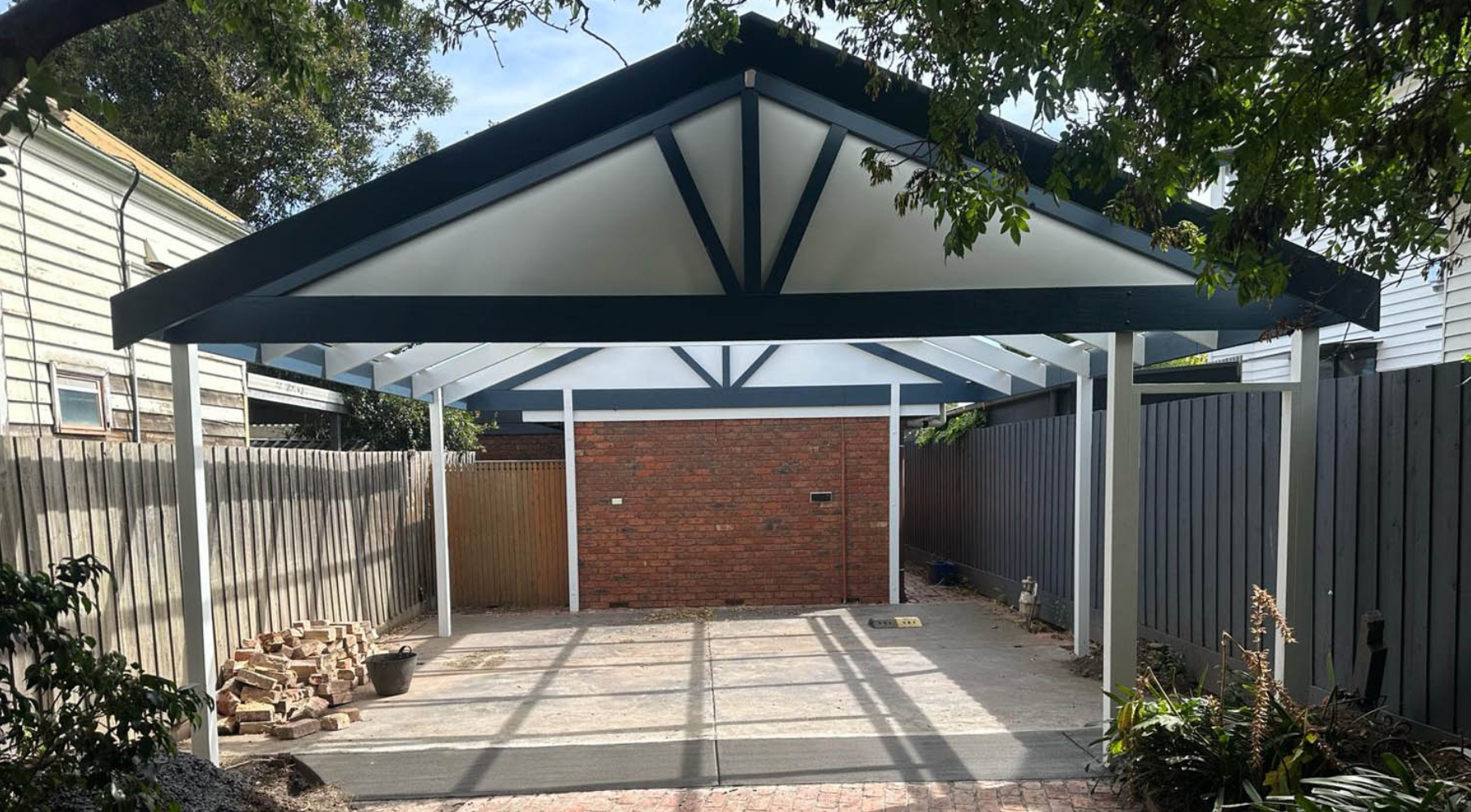
Designing Practical and Stylish Carports, Pergolas and Verandahs in Melbourne’s Bayside Suburbs
Melbourne’s Bayside suburbs are known for their stunning coastal views, relaxed lifestyle, and mix of heritage and contemporary homes. When it comes to designing carports, pergolas and verandahs for their homes in Bayside, homeowners need to consider design, practicality and aesthetics. Choosing the right design ensures your outdoor structure complements your home, suits your lifestyle, and stands the test of time.
Whether you live in Brighton, Beaumaris, Sandringham, or Black Rock, this guide will help you explore key design considerations and create a functional yet stylish addition to your property.
Understanding Bayside’s Unique Environment
The Bayside area presents distinct design challenges and opportunities. With its proximity to the coast, homes here experience higher exposure to salt air, strong winds, and sun. When designing a carport, pergola, or verandah, it’s essential to factor in these conditions to ensure comfort, practicality and longevity.
- Salt Air Exposure: Materials need to be resistant to long term corrosion and weathering, or be protected from the elements by covering with other materials and painting.
- Strong Coastal Winds: Structures should be sturdy and well-anchored. Preference should be given to posts that are direct buried in concrete footings rather than post-fixed to concrete slabs with stirrups. The choice and quality of blinds is important so that unwanted noise and movement during windy conditions is limited.
- Heritage & Modern Home Styles: The design should complement existing architectural elements of your home and façade in particular.
Design Considerations for your Outdoor Area
Here are some practical and aesthetic factors to consider when designing your pergola, verandah or carport:
1. Open vs. Enclosed Areas
- Open structures allow for better airflow and are more cost-effective and simpler to build. These designs are generally built without too much fuss and the permit process is generally quick and easy as long as the design complies with Building Regulations.
- Partially enclosed structures with slatted screens or feature walls provide added privacy while maintaining a light and airy feel. Composite timber or powder-coated steel or aluminium section can be used for this purpose.
- Fully enclosed structures offer maximum protection but require additional budget to pay for closing off the sides. Closing one or two sides of a carport can necessitate the requirement for a Fire Engineering Report in order obtain a Building Permit.
2. Roof Style and Materials
- Flat Roofs: These are also referred to as skillion roofs and are simple, cost-effective and modern. It is important to consider finished ceiling height as the area may become impractical if the ceiling height is limited. Flat roof s can be designed to achieve a minimum 1deg fall with the use of specialised colorbond roof sheets that are stronger and have concealed fixing, although the most common pitch for these roofs ranges from 2 deg to 5 deg falls.
- Gabled Roofs: More traditional, the main advantage of a gable roof design is the additional ceiling height achieved at the ridge of the structure allowing for a more open feel and spacious feel and ability to install ceiling fans. Gable roofs are significantly less expensive to build in timber framing as opposed to steel framing, with a few variances in roof shape available including hip and dutch gable designs.
- Colorbond Roofing: Highly durable, strong and available in various colours to match your home. Various profiles are available in the market to suit preference, pitch of roof and span between purlins.
- Polycarbonate Panels: the main advantage of polycarbonate roof sheeting is its ability to allow natural light to penetrate through the sheet and into outdoor living spaces and into your home through windows. They provide UV protection and come in a range of shades and colours to suit the specific requirements and preferences of the homeowner.
3. Integration with Surrounding Areas and Landscaping
- The design of your pergola, verandah or carport should consider characteristics of the surrounding areas for better integration. Things such position and styles of existing gable roofs, existing porch and verandah designs should be considered at concept design phase before drawings are submitted to council.
- Adding climbing plants or decorative screens softens the structure and adds visual appeal.
We design and build custom pergolas in Keilor, Sunbury, and across Melbourne to suit your home and lifestyle.
Pergola Design Considerations for Coastal Living
A pergola can transform an outdoor space into a versatile living area. In the Bayside suburbs of Melbourne where entertaining and relaxing outdoors is a way of life, the right pergola design makes all the difference.
1. Positioning for Sun and Wind Protection
- A north-facing pergola captures the most sunlight—ideal for cooler months. Roofing options should consider practicality and sustainability in all seasons as well as energy efficiency.
- A west-facing pergola requires additional shading due to the harsh afternoon sun. Although the late afternoon sun is a welcome guest in winter, your outdoor area can be very uncomfortable and make it unlikely for homeowners to favour over an indoor airconditioned space. So insulation and shading are considerations that should be well thought out.
- Coastal winds should be considered; panels or glass screening should be considered as windbreaks over blinds for areas exposed to high winds.
2. Roofing Options for Year-Round Comfort
- Colorbond Roofing: Durable and protective, ideal for full shade, relatively better heat protection and a maintenance-free option.
- Polycarbonate Roofing: Allows natural light in while offering UV protection. The various shades and colours available in the market give it flexibility in terms of meeting the specific preferences in terms of heat vs light.
- Louvre Systems: Adjustable roofing that gives flexibility between sun and shade. These come in automatic rain-sensing operable systems or with blades fixed in position to act as privacy screens.
- Combination Roofing: A mix of colorbond and polycarbonate translucent panels for a balance between light and coverage.
3. Material Selection for Coastal Conditions
- Galvanised Steel: All steel components such as bolts and nuts, brackets and beams should be galvanised to protect from rust.
- Powder-Coated Steel: Attractive and resistant to rust and requires minimal maintenance. Colour choices can be selected from Colorbond colour charts and is available in gloss or matt finishes.
- Timber: If opting for timber, ensure it is treated and painted with high quality external grade paint. If you prefer to stain the timber to maintain its natural look, then staining should be repeated each year to adequately protect the timber.
- Composite Materials: Low-maintenance alternatives such as composite timber that mimic the look of timber are a good, sustainable option. Produced from 50/50 recycles plastic and wood fibres, they are a fantastic environmentally friendly alternative to natural timbers. The initial additional cost for the material pays for itself over time with savings in maintenance.
4. Enhancing Your Pergola with Outdoor Features
- Built-in Seating & Storage: Space-saving and practical for small backyards.
- Outdoor Heaters or Fire Pits: Extend usability during colder months.
- Greenery & Climbing Plants: Bougainvillea, jasmine, and even grapevines thrive in Bayside’s climate.
Verandah Design for Bayside Heritage & Modern Homes
A verandah adds charm, function, and street appeal. Whether your home is a classic Victorian in Brighton or a modern beachside property in Hampton, the design should be in harmony with your home’s façade.
1. Matching Architectural Styles
- Heritage Homes: Decorative timber posts, fretwork, and traditional colours work well.
- Modern Homes: Sleek lines, minimalist balustrades, and neutral tones suit contemporary designs.
2. Flooring Choices for Durability and Style
- Timber Decking: A warm and natural choice, but requires sealing against moisture.
- Composite Decking: Mimics timber but is more durable in coastal environments. Most composite boards are produced by combining wood fibres and recycled plastic, making it an environmentally friendly and sustainable choice for homeowners.
- Tiled or Paved Surfaces: Low-maintenance and available in styles to match any home.
3. Practical Additions for Year-Round Use
- Blinds or Shutters: Protect against wind and sunlight while allowing airflow.
- Ceiling Fans: Keep the space cool on warm days, creating air circulation.
- Integrated Lighting: Downlights or pendant lights add functionality and ambiance.
For expert carport installation and building services in Melbourne, including Sunbury and Werribee, consider reaching out to Custom Carports and Pergolas.
Customisation and Personal Touches
A well-designed carport, pergola, or verandah should reflect your lifestyle and needs. Customisation ensures that your structure is both practical and visually appealing.
- Privacy Screens & Greenery: Help create a secluded retreat.
- Smart Lighting: Enhances ambiance for evening gatherings, and enhances security.
- Decorative Elements: Such as feature walls, laser-cut screens, or painted finishes.
Final Thoughts on Bayside Outdoor Structures
For homeowners in Beaumaris, Sandringham, and surrounding Bayside suburbs, designing a functional and stylish outdoor structure involves balancing durability, aesthetics, and climate considerations. Whether you’re looking to protect your car, create a relaxing outdoor retreat, or add value to your home, thoughtful design makes all the difference.
If you need expert guidance on designing a carport, pergola, or verandah suited to Bayside’s coastal environment, Custom Carports and Pergolas can provide tailored solutions to enhance your outdoor space. We look forward to working with your Bayside outdoor home extension project.


